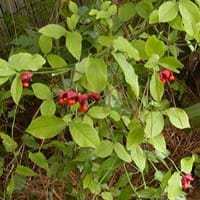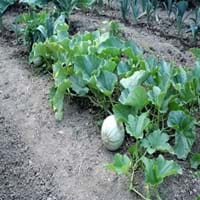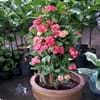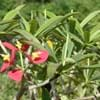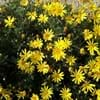Life Span
Perennial
Annual
Origin
Northeastern United States, Mid-Atlantic United States, Southeastern United States, South-Central United States
Hybrid origin, Africa
Types
Not Available
C melo subsp melo
Habitat
Shady Edge, Woodland Garden Dappled Shade
gardens, Temperate Regions, Terrestrial
USDA Hardiness Zone
6-8
Not Available
Sunset Zone
3b, 4, 5, 6, 7, 8, 9, 14, 15, 16, 17
2a, 2b, 3a, 3b, 4, 5, 6, 7, 8, 9, 10, 11, 12, 13, 14, 15, 16, 17, 18, 19, 20, 21, 22, 23, 24
Habit
Upright/Erect
Vining/Climbing
Flower Color
White, Ivory
Yellow
Flower Color Modifier
Not Available
Bicolor
Fruit Color
Magenta, Orange, Red
White, Yellow, Light Yellow, Gold, Tan, Sandy Brown
Leaf Color in Spring
Green
Green, Light Green
Leaf Color in Summer
Green
Green, Light Green
Leaf Color in Fall
Yellow, Red, Burgundy
Green, Light Green
Leaf Color in Winter
Not Available
Light Green
Leaf Shape
Lance shaped
Oval
Plant Season
Fall, Winter
Summer, Fall
Sunlight
Full Sun, Partial Sun, Partial shade, Full Shade
Full Sun
Growth Rate
Medium
Very Fast
Type of Soil
Clay, Loam
Loam
The pH of Soil
Acidic, Neutral
Neutral
Soil Drainage
Well drained
Well drained
Bloom Time
Early Summer
Indeterminate
Tolerances
Drought
Drought
Where to Plant?
Ground, Pot
Container, Ground
How to Plant?
Seedlings, Semi-hardwood cuttings
Seedlings, Transplanting
Plant Maintenance
Medium
Medium
Watering Requirements
Average Water Needs, Do Not over Water
Do Not over Water, Keep the ground moist but not water-logged, Never Over-water, Requires a lot of watering, Requires regular watering, Requires watering in the growing season, Water Deeply
In Summer
Lots of watering
Lots of watering
In Spring
Moderate
Moderate
In Winter
Average Water
Average Water
Soil pH
Acidic, Neutral
Neutral
Soil Type
Clay, Loam
Loam
Soil Drainage Capacity
Well drained
Well drained
Sun Exposure
Full Sun, Partial Sun, Partial shade, Full Shade
Full Sun
Pruning
Remove damaged leaves, Remove dead branches, Remove dead leaves
Remove Vines
Fertilizers
All-Purpose Liquid Fertilizer
All-Purpose Liquid Fertilizer
Pests and Diseases
Red blotch
Red blotch
Plant Tolerance
Drought
Drought
Flowers
Insignificant
Showy
Flower Petal Number
Single
Single
Foliage Texture
Medium
Coarse
Foliage Sheen
Matte
Matte
Attracts
Birds, Deers
Not Available
Allergy
Diarrhea, poisonous if ingested
Abdominal pain, breathing problems, Diarrhea, Dizziness, Nausea, Vomiting
Aesthetic Uses
Not Used For Aesthetic Purpose
Not Used For Aesthetic Purpose
Beauty Benefits
Not Available
Not Available
Environmental Uses
Air purification
Air purification
Medicinal Uses
constipation, Liver problems, Malaria, Tonic
anti-cancer, Antioxidants, Cardiovascular problems, Combats Stress, Eye Problems, Immunity, Insomnia
Part of Plant Used
Bark, Root, Seeds
Fruits
Other Uses
The powdered bark is believed to eliminate dandruff, Used to make tea in cases of uterine prolapse, vomiting of blood
Economic Purpose, Employed in herbal medicine, Used As Food
Used As Indoor Plant
No
No
Used As Outdoor Plant
Yes
Yes
Garden Design
Mixed Border
Edible, Fruit / Fruit Tree, Herb / Vegetable, Vine
Botanical Name
EUONYMUS americanus
CUCUMIS melo
Common Name
Strawberry bush, American strawberry bush, Bursting-heart
Cantaloupe, Casaba Melon, Honey Dew, Melon, Muskmelon
In Hindi
Strawberry Bush
खरबूजा
In German
Strawberry Bush
Cantaloup Melone
In French
Strawberry Bush
Cantaloup
In Spanish
Fresa Bush
Cantalupo
In Greek
φράουλα Μπους
Πεπονάκι
In Portuguese
Morango de Bush
Cantalupo
In Polish
Strawberry Bush
Kantalupa
In Latin
Classic Bush
cantaloupe
Phylum
Magnoliophyta
Tracheophyta
Class
Magnoliopsida
Magnoliopsida
Order
Celastrales
Cucurbitales
Family
Celastraceae
Cucurbitaceae
Clade
Angiosperms, Eudicots, Rosids
Angiosperms, Eudicots, Rosids
Tribe
Not Available
Melothrieae
Subfamily
Celastroideae
Cucurbitoideae
Number of Species
Not Available
Not Available
Importance of Strawberry Bush and Cantaloupe
Want to have the most appropriate plant for your garden? You might want to know the importance of Strawberry Bush and Cantaloupe. Basically, these two plants vary in many aspects. Compare Strawberry Bush and Cantaloupe as they differ in many characteristics such as their life, care, benefits, facts, etc. Every gardener must at least have the slightest clue about the plants he wants to plant in his garden. Compare their benefits, which differ in many ways like facts and uses. The medicinal use of Strawberry Bush is constipation, Liver problems, Malaria and Tonic whereas of Cantaloupe is anti-cancer, Antioxidants, Cardiovascular problems, Combats Stress, Eye Problems, Immunity and Insomnia. Strawberry Bush has beauty benefits as follows: Not Available while Cantaloupe has beauty benefits as follows: Not Available.
Compare Facts of Strawberry Bush vs Cantaloupe
How to choose the best garden plant for your garden depending upon its facts? Here garden plant comparison will help you to solve this query. Compare the facts of Strawberry Bush vs Cantaloupe and know which one to choose. As garden plants have benefits and other uses, allergy is also a major drawback of plants for some people. Allergic reactions of Strawberry Bush are Diarrhea and poisonous if ingested whereas of Cantaloupe have Abdominal pain, breathing problems, Diarrhea, Dizziness, Nausea and Vomiting respectively. Having a fruit bearing plant in your garden can be a plus point of your garden. Strawberry Bush has showy fruits and Cantaloupe has showy fruits. Also Strawberry Bush is not flowering and Cantaloupe is not flowering . You can compare Strawberry Bush and Cantaloupe facts and facts of other plants too.
